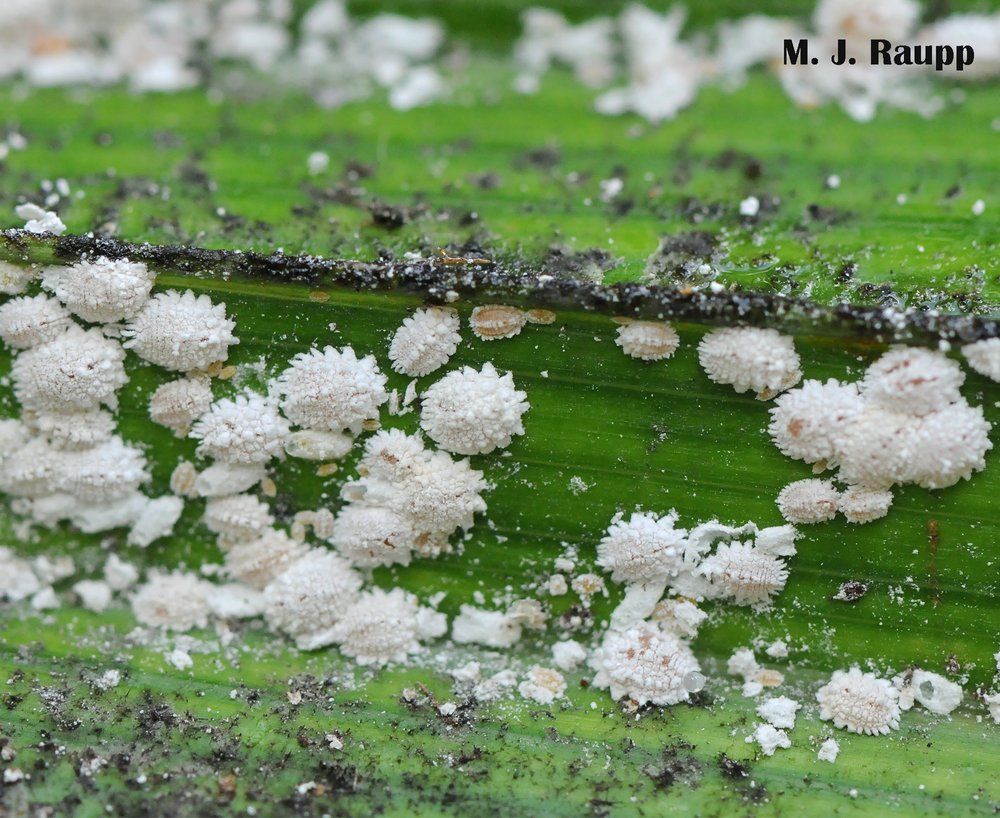From the mailbag – Mealybugs, Pseudococcidae, in the greenhouse and their destroyer, Cryptolaemus montrouzieri

On leaves heavily infested by mealybugs it is not unusual to find both adult and larval mealybug destroyers. The waxy filaments adorning the beetle larva may help protect the larva from attack by its own enemies.
In a previous episode we learned of trouble in the greenhouse brought on by tiny thrips wreaking havoc on white swamp lilies. This week we return to the greenhouse where yet another sucking insect is pestering our growers. Mealybugs are a clan of mostly tropical and semitropical sucking insects that often outbreak on plants in greenhouses, interiorscapes, and homes wherever indoor plants are grown. One common offender is the citrus mealybug. Originally native to Asia, the citrus mealybug has been recorded in the United States since 1879 and is now found in Asia, North, South, and Central America, Europe, and Oceana. They are major pests of fruits such as citrus, grapefruit, and bananas but are known to dine on plants from more than 60 plant families. Yikes!

In tropical and semitropical realms, mealybugs like these dining on a palm frond reach astounding densities.
Like aphids, soft scales, bark scales, whiteflies, and lanternflies we met in previous episodes, mealybugs insert sucking mouthparts into phloem vessels and imbibe sap. This robs plants of vital nutrients which results in yellow foliage, distorted leaves and buds, premature leaf drop, and plant death. As with other phloem feeders, all that sucking and processing of liquid food results in the excretion of vast amounts of sweet sticky honeydew. Recall that honeydew is the substrate for the growth of unsightly sooty mold which disfigures foliage, blossoms, and fruit. This sugar-rich liquid attracts ants and stinging insects. Cold winter temperatures prevent citrus mealybugs from surviving in most states here in the US, but in the warmth of Florida and California they complete several generations annually and indoors they can survive and reproduce year-round. With females able to produce up to 600 eggs, it’s easy to see how populations can explode seemingly overnight. Female mealybugs are flightless, so infestations often begin when previously infested plants arrive in a greenhouse or home. Tiny mealybug nymphs ride air currents to move from one plant to another.
Watch as an adult mealybug destroyer moves across an infested leaf and gobbles up small mealybug nymphs along the way. On another leaf, the wax covered larva of a mealybug destroyer searches for prey and when it finds one, it settles in for a juicy mealybug meal topped off with a little wax.

Fair hibiscus, though your buds may be withered by the dreaded mealybug, fear not. The destroyer is nigh to bring an end to your season of terror.
But all is not lost for our grower and the greenhouse plants under his care. Citrus mealybug has a powerful foe, the mealybug destroyer which has been released in the greenhouse. Native to Australia, this small lady beetle was imported to southern California by pioneering entomologist Albert Koebele in the late 1800’s to help control citrus mealybug, which threatened California’s burgeoning citrus industry. This classical biological control success story has been repeated in other countries around the globe and the mealybug destroyer is now found the Americas, Europe, Africa, and Oceana. While adults certainly have a lady beetle mien, their youngsters don’t appear very beetle-like at all. Immature stages of this tiny terror are cloaked in white wax and appear much more like mealybugs than beetle larvae. Scientists believe this may be a clever ruse to fool potential predators such as ants that protect honeydew-producing insects like mealybugs. By resembling their prey, larval mealybug destroyers may escape the fierce jaws of ants defending mealybugs. Both adults and larvae of the destroyer have a keen appetite not only for citrus scale but for other pestiferous scale insects as well. They can be purchased commercially and are part of the natural enemy arsenal used to put a beat-down on mealybugs around the world.
Acknowledgements
We thank Nancy Harding and Sam Bahr for sharing their mealybugs and mealybug destroyers which inspired this episode. To learn more about mealybugs and the mealybug destroyer please click on links at these uber-informative websites at the University of California IPM websites:
https://ipm.ucanr.edu/PMG/PESTNOTES/pn74174.html
https://ipm.ucanr.edu/natural-enemies/mealybug-destroyer/
This post appeared first on Bug of the Week